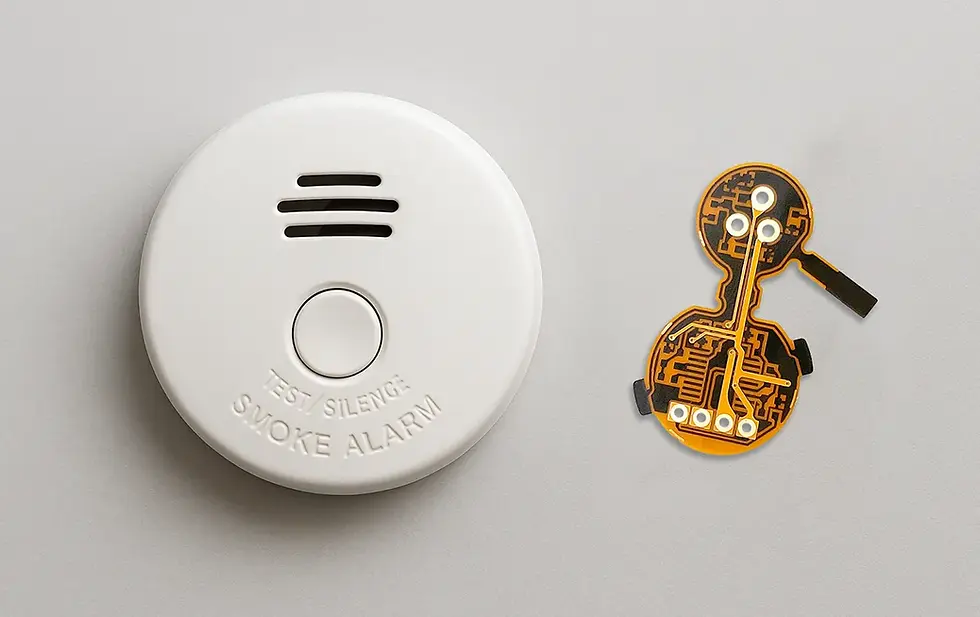Flex PCB in Smoke Detectors
- Flex Plus Tech team

- Jun 26
- 3 min read
Introduction
I believe most people know about flex PCB, but did you know that flex PCB can be used in Smoke Detectors? Smarter, smaller, and more reliable fire safety systems are in high demand today. A key technology driving innovation in this area is the Flexible Printed Circuit.
At Flex Plus, we specialize in high-performance flex PCB solutions for a wide range of industries, including fire safety and security systems. In this article, we’ll look at how flexible circuit boards support smoke detection technology, the benefits they offer, the challenges in integrating them, and why Flex Plus is the trusted choice for OEMs and device manufacturers around the world.
How Smoke Detectors Work
Smoke detectors are very important in our lives. There are two main types of smoke detectors:
Ionization Smoke Detectors: These detect invisible combustion particles and are more responsive to flaming fires.
Photoelectric Smoke Detectors: These are more sensitive to smoldering fires and use a light sensor and optical chamber.
Modern smoke detectors often combine both technologies to offer comprehensive protection. Additionally, advanced models include wireless communication, battery monitoring, smart integration with IoT systems, and even voice alerts—all of which increase the circuit complexity inside the device. This is where flex PCB technology becomes critical.

Why Use Flex PCB in Smoke Detectors?
Integrating flexible circuit boards into smoke detectors offers several key benefits that improve performance, reliability, and ease of manufacturing:
1. Compact Size and Save Space
Smoke detectors are usually mounted on ceilings or walls. Flexible circuit boards support 3D assembly, allowing the circuits to bend and fold to fit into tight or unusual spaces. This is essential for designing modern, slim detectors with multiple features in a small form factor.
2. Lightweight Construction
Flexible PCBs are much lighter than traditional rigid boards. This is especially valuable for battery-powered smoke alarms, where weight matters. A lighter design also makes installation easier and safer.
3. Durable and Long Lifespan
Flexible circuit boards are built to resist temperature changes, vibration, and moisture. This makes them ideal for both residential and industrial settings. Smoke detectors often need to work for many years without maintenance. Flex Plus flex PCBs deliver reliable performance and long-term durability, even in tough environments.
4. Simplified Assembly and Better Connectivity
Flex circuits take the place of bulky connectors, wires, and ribbon cables. This not only cuts down on parts but also makes assembly easier and more reliable — a big win for mass production. With fewer connection points, there’s less chance of loose contacts or soldering issues.
5. Support for Advanced Features
Smoke detectors are becoming smarter, with IoT connectivity, self-testing, and multi-sensor integration. Flexible circuit boards make it easier to include microcontrollers, RF modules, sensors, LEDs, and power systems on a single, compact board, and maintain performance or signal quality.
Applications of flex PCB in Smoke Detection Systems
Flex Plus flexible circuit boards are engineered for a wide variety of tasks within a smoke detection system, such as:
Main control board connection
Sensor module interfacing
Battery terminals and power lines
LED indicator circuits
Alarm speaker or piezo buzzer connections
Wireless module integration (Wi-Fi/Zigbee/Bluetooth)
Design Considerations for flex PCB in Smoke Detectors
When making flexible circuit boards for smoke detectors, there are some important things to consider. These help make sure the boards work well and meet the required standards.
Material Selection: Polyimide films are preferred due to their excellent thermal resistance and electrical insulation properties.
Trace Routing and Shielding: To reduce EMI and crosstalk, especially near RF components.
Connector Compatibility: flexible circuit boards must match with ZIF connectors or be designed for direct soldering, depending on product architecture.
Flex Cycles: Although smoke detectors are static, durability during manufacturing and installation must be tested.
UL Certification: Materials and processes must meet regulatory standards for flammability and reliability.
At Flex Plus, we ensure all our flexible circuit boards meet UL, IPC, and RoHS standards.
Conclusion
Flexible circuit boards are changing the way smoke detectors are manufactured. With their bendable design, small size, and superior reliability, flexible circuit boards enable smarter, more compact devices that keep people safer.
At Flex Plus, we are committed to creating high-quality flexible PCB solutions for our customers. Whether you are developing a simple domestic smoke alarm or a complex industrial sensor, we can help you produce the right flexible PCB to make your design a reality.
Want to learn more about what we can do? Get in touch with us now, we’d be happy to talk or provide a custom quote for your project.




Comments